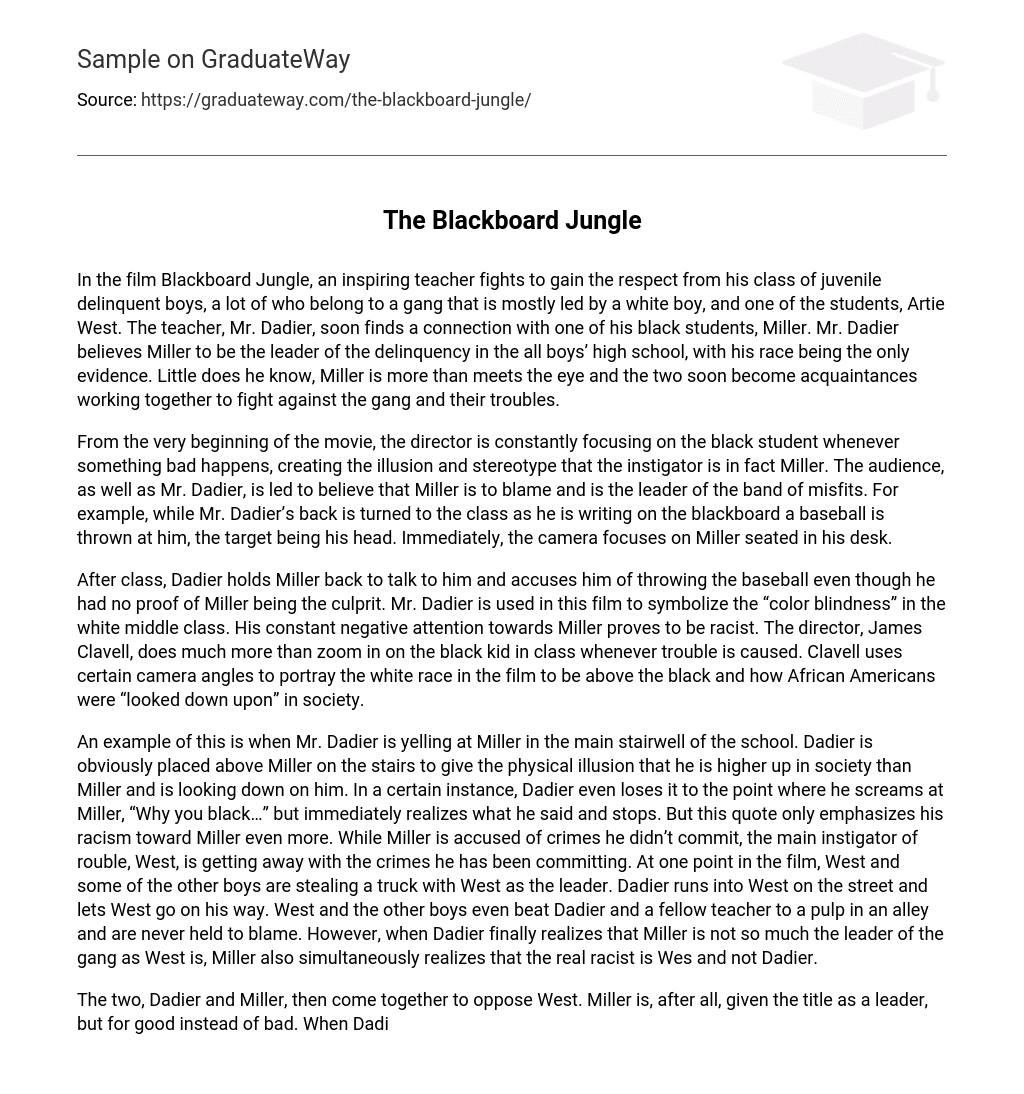In the movie Blackboard Jungle, a teacher faces difficulties in gaining respect from his troubled class of boys. The majority of these students are part of a gang led by Artie West, who is Caucasian. Mr. Dadier forms a connection with Miller, an African American student. Unfortunately, Mr. Dadier mistakenly believes that Miller is responsible for the delinquency in their all-boys high school solely because of his race. Unbeknownst to him, Miller possesses hidden qualities and they ultimately unite forces to confront the gang and overcome their obstacles.
Throughout the movie, the director consistently highlights the black student whenever something negative occurs, perpetuating the notion that Miller is the troublemaker and conforming to stereotypes. This portrayal leads both the audience and Mr. Dadier to believe that Miller is responsible and the ringleader of the misfit group. For instance, when Mr. Dadier is facing away from the class and writing on the blackboard, a baseball is thrown at his head. At this moment, the camera immediately zooms in on Miller who is seated at his desk.
After class, Dadier talks to Miller and accuses him of throwing the baseball without any evidence. Dadier symbolizes the “color blindness” of the white middle class in this film. His constant negative treatment of Miller shows racism. The director, James Clavell, does more than just focus on the black kid in class when trouble arises. Clavell uses specific camera angles to depict the superiority of the white race and how African Americans were viewed lower in society.
An example of this is when Mr. Dadier is yelling at Miller in the main stairwell of the school. Dadier is positioned higher up on the stairs to create the visual perception that he has a higher social standing than Miller and is looking down on him. There is a moment where Dadier loses control and yells at Miller, using a racial slur, but immediately recognizes his mistake and stops. However, this quote only further emphasizes his racism towards Miller. While Miller is falsely accused of crimes, the primary troublemaker, West, is getting away with the crimes he has committed. There is a scene where West and some other boys steal a truck, with West as their leader. Dadier encounters West on the street and allows him to escape without consequence. In an alley, West and the other boys brutally beat Dadier and a fellow teacher, yet they are never held accountable for their actions. Eventually, Dadier realizes that Miller is not the true leader of the gang, but it is actually West. Simultaneously, Miller also comes to the realization that the real racist is Wes, not Dadier.
Dadier and Miller join forces to confront West, with Miller assuming the role of a positive leader. As Dadier battles against West and his unruly followers, Miller supports him, along with numerous classmates. Within society, these boys are perceived as “animals”. Cesare Lombroso, an Italian criminologist influenced by Darwin’s theories during the late 19th century, classified certain criminals as primitive individuals who did not progress on the evolutionary tree.
In the opening scene of Blackboard Jungle, there is an apparent reference to the theory mentioned earlier. This is depicted by Bill Haley and His Comets playing in the background while all-male students are seen behaving rowdily in the schoolyard. Some of them even imitate chimps by walking on their hands. The use of a tall metal fence around the schoolyard further enhances this notion of separation between the students and the outside world that abides by the law. The scene then becomes more reminiscent of a zoo as the boys extend their hands through the bars of the fence towards a passing female, accompanied by crude sounds, gestures, and facial expressions.
The concept of the “delinquent subculture” was implied by the apparent alienation of Dadier’s students from mainstream America. This animalistic image was further reinforced through dialogue. Murdock, a cynical teacher, referred to the students as “those wild animals,” and Dadier himself described his class as “screaming wild animals.” The film Blackboard Jungle, set in a boys’ high school, perpetuated the notion that the criminal world was predominantly male. The only notable female characters in the film were teacher Lois Hammond and Mr.’s pregnant wife.
Dadier, Anne Dadier, both experienced victimization from delinquent students. The student behavior was so unruly that Hammond was warned about the possibility of needing the National Guard’s protection in case she dressed somewhat provocatively. Additionally, this film effectively depicts a purported link between low intelligence and a tendency towards criminal behavior. It is widely recognized that inadequate academic performance is strongly correlated with delinquency. The boys in Mr. Dadier’s class are anticipated to be in their final year.
Despite their lack of education, the boys in Dadier’s class frequently participate in criminal activities and cause harm to others. Nevertheless, Dadier endeavors to establish a connection between education and criminal behavior by teaching them fundamental grammar, sentence structure, and word choice. Conversely, there is a boy who is commonly labeled as an “idiot boy,” yet he seems to be one of the most law-abiding students. In the concluding scene, when West and the gang engage in a fight against Dadier and Miller, the idiot boy emerges as a heroic figure opposing those engaged in wrongdoing.
In this movie, juvenile delinquent boys are examined within a society governed by law-abiding middle-class individuals. The boys are depicted in a beastly manner, showcasing their stereotypical rowdiness and their resistance to rehabilitation. The film explores the role of education in influencing one’s inclination towards a life of crime and also highlights the potential for positive change by challenging traditional notions of gender, race, and social status.





